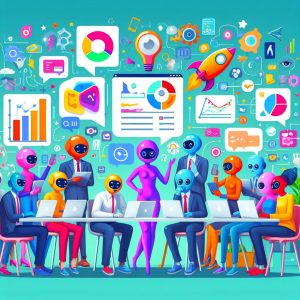Introduction:
In the rapidly evolving landscape of advertising, artificial intelligence (AI) has emerged as a game-changer. With its ability to process vast amounts of data, identify patterns, and make predictions, AI is fundamentally reshaping the way advertising executives approach marketing strategies, consumer engagement, and advertising campaigns. In this blog, we will explore how AI is transforming the advertising industry and the critical role it plays in driving innovation and growth.
1. Data-Driven Marketing:
AI has revolutionized the way advertising executives collect, analyze, and leverage data. AI-powered data analytics tools sift through vast amounts of structured and unstructured data, including consumer behavior, preferences, demographics, and engagement patterns. This wealth of data enables advertising executives to gain deeper insights into consumer behavior, segment audiences more effectively, and deliver highly personalized messages.
2. Real-Time Optimization:
AI algorithms enable advertising executives to optimize advertising campaigns in real-time. By continuously monitoring campaign performance and analyzing consumer feedback, AI can identify underperforming ads, adjust ad placements, and optimize campaign budgets. This data-driven, iterative approach leads to improved campaign effectiveness, increased ROI, and better alignment with consumer preferences.
3. Predictive Behavior Analytics:
AI plays a vital role in predicting consumer behavior. AI algorithms analyze historical data and real-time consumer interactions to predict future behaviors, preferences, and purchasing patterns. This predictive capability allows advertising executives to anticipate consumer demands, tailor marketing messages, and deliver personalized recommendations, ultimately enhancing the overall customer experience.
4. Enhanced Targeting and Personalization:
AI-powered advertising platforms enable sophisticated targeting and personalization capabilities. By analyzing consumer data, AI can create highly specific audience segments based on demographic, psychographic, behavioral, and geographic attributes. This allows advertising executives to target ads with greater precision, ensuring that the right messages reach the right consumers at the right time.
5. Creative Content Generation:
AI is increasingly employed to generate creative content for advertising campaigns. AI-powered tools can create visually appealing images, compelling ad copy, and engaging videos that resonate with specific audience segments. This capability helps advertising executives produce high-quality content at scale, reducing production costs and improving campaign efficiency.
6. Chatbot and Conversational AI:
Chatbots powered by AI provide personalized customer service and support. These virtual assistants can engage in natural language conversations, answer consumer queries, resolve issues, and offer product recommendations. By integrating AI-powered chatbots into advertising campaigns, companies can enhance customer engagement, improve brand loyalty, and generate qualified leads.
7. Measurement and Attribution Analytics:
AI plays a crucial role in measuring the effectiveness of advertising campaigns. AI-powered analytics tools track consumer interactions across multiple channels, attributing conversions to specific touchpoints. This granular level of measurement enables advertising executives to understand what drives customer actions, optimize campaigns accordingly, and demonstrate the value of advertising investments.
AI has undoubtedly transformed the advertising industry, bringing forth a new era of data-driven marketing, personalized experiences, and improved campaign performance. Advertising executives who embrace AI and leverage its capabilities can stay ahead of the curve, create more effective campaigns, and deliver exceptional consumer experiences. As AI continues to advance, we can anticipate even more groundbreaking applications and innovations that will further shape the future of advertising.
The marketing industry is undergoing a transformative shift, driven by the rapid advancements in artificial intelligence (AI). While AI presents exciting opportunities for enhanced efficiency and effectiveness, it also raises concerns about job displacement and the future of traditional roles. In this blog, we will delve into the dangers and possibilities associated with the advertising executive job, exploring how AI will impact the profession and how professionals can adapt to the evolving landscape.
Dangers for Advertising Executive Job:
- Automation of Routine Tasks: AI-powered tools can automate mundane and repetitive tasks, potentially replacing the need for human advertising executives.
- Diminished Creativity: Critics argue that AI’s focus on data and analytics may limit creativity and the unique human insights that advertising executives bring to the table.
- Job Redundancy: As AI becomes more sophisticated, it may lead to job redundancy, particularly for those who rely on traditional methods of advertising and lack the necessary skills to embrace AI.
- Lack of Emotional Intelligence: AI lacks emotional intelligence and empathy, which are critical for understanding consumer behavior and creating persuasive advertising campaigns.
Possibilities of Job Being Replaced by AI:
- Enhanced Efficiency: AI can handle large volumes of data, analyze consumer patterns, and optimize advertising campaigns with greater efficiency and accuracy.
- Improved Targeting: AI-powered algorithms can analyze consumer data to deliver personalized advertising messages, leading to increased engagement and conversions.
- Creative Augmentation: Rather than replacing creativity, AI can serve as a tool to augment and enhance human creativity, enabling advertising executives to generate innovative and data-driven ideas.
- Strategic Decision-making: AI can assist advertising executives in making informed strategic decisions, leveraging data insights to identify market opportunities and mitigate risks.
How AI Will Be Used to Help in the Job:
- Data Analysis and Insights: AI can analyze vast amounts of data to uncover consumer insights, preferences, and trends, enabling advertising executives to develop more effective campaigns.
- Personalized Advertising: AI can help create personalized advertising experiences by tailoring messages and content to individual consumer profiles and behaviors.
- Predictive Analytics: AI algorithms can predict consumer behavior and identify potential customers, allowing advertising executives to target the right audience at the right time.
- Content Generation: AI-powered tools can assist in generating creative content, such as ad copy, images, and videos, that resonate with the target audience.
- Performance Optimization: AI can monitor advertising campaign performance in real-time and make adjustments to optimize results and maximize ROI.
How to Adapt to the Changing Landscape:
- Embrace AI as a Tool: Advertising executives should embrace AI as a powerful tool that can enhance their creativity and effectiveness. By leveraging AI’s capabilities, they can gain valuable insights, improve targeting, and optimize campaign performance.
- Develop Technological Skills: To stay competitive, advertising executives need to develop technological skills, such as data analysis, programming, and AI implementation. This will enable them to work effectively with AI-powered tools and maximize their benefits.
- Focus on Strategic Thinking: While AI can handle routine tasks and data analysis, advertising executives should focus on developing strategic thinking skills. They should concentrate on understanding market dynamics, consumer behavior, and competitive landscapes to make informed decisions.
- Cultivate Creativity: Advertising executives need to cultivate their creativity and unique human insights. They should use AI as a tool to augment their creativity and generate innovative ideas that resonate with consumers on an emotional level.
- Collaborate with AI: Advertising executives should view AI as a collaborative partner rather than a replacement. By working closely with AI-powered tools, they can leverage data and technology to enhance their decision-making and achieve superior results.
Conclusion:
The advertising executive job is undergoing a transformative change driven by the rise of AI. While it presents certain dangers and the possibility of job displacement, AI also offers immense opportunities for enhanced efficiency, effectiveness, and creativity. By embracing AI as a tool, developing technological skills, focusing on strategic thinking, cultivating creativity, and collaborating with AI, advertising executives can adapt to the changing landscape and thrive in the new era of AI-driven marketing.



